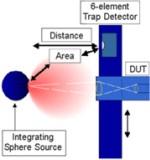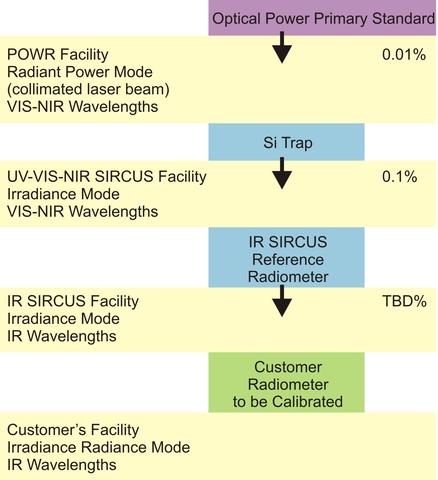SIRCUS facility and uncertainties

The basic SIRCUS calibration setup is shown at the right. The output from a tunable laser is sent through an intensity stabilizer, then through a 'speckle removal system' (typically an ultrasonic bath for fiber-coupled systems like in the UV-Vis-NIR SIRCUS) and into the integrating sphere. Beamsplitters send some of the laser radiation into a spectrum analyzer and a wavemeter to monitor the spectral properties and the wavelength of the light. The irradiance is measured first by the reference instrument and the radiometric quantity is measured by the Radiometer Under Test. A monitor detector on the wall of the integrating sphere accounts for any laser intensity changes between the two measurements. A linear encoder records the position of the radiometer stage and is used to radiometrically determine the distance between the sphere and the irradiance detector reference plane (using the inverse square law). A computer controls the measurement sequence and records the data.
The lasers and output powers used in the UV-Vis-NIR SIRCUS are shown below. Several different tunable lasers are used. The UV region (200 nm to 400 nm) a pulsed laser (Ti-Sapphire) is used, but has been verified to be equivalent to continuous-wave (cw) lasers for standard detector calibrations. We are working to further extend the current range of wavelength coverage.

SIRCUS uncertainties:
The SIRCUS facility provides the state-of-the-art low uncertainty calibration for various optical radiometers and instruments used in many applications. Currently an expanded uncertainty of 0.08 % (k=2) is achievable for an irradiance responsivity calibration in the visible and near IR region for high-quality instruments. The primary uncertainty components and their estimated magnitude are listed below.

For the IR spectral range, a liquid-helium-cooled Electrical Substitution Bolometer (ESB) is characterized and calibrated against irradiance mode Si trap radiometers and is used as the reference detector. InGaAs and InSb working standards are used for cases where adequate uncertainty can be achieved more conveniently.

The uncertainty for irradiance responsivity measurements that have been done to date is currently at about 3 % (k=2), and current developments are directed at reducing this to a general goal of 0.2 % (k=1) Also, the IR-SIRCUS is an optimum monochromatic uniform source facility that can provide detector-based calibration support for digital imaging systems such as detector arrays, infrared cameras, IR focal plane array radiometers, and spectrometers.

The increased accuracy of transfer and working standard radiometers, calibrated on the IR-SIRCUS facility, will increase the accuracy of radiometric measurements in the infrared wavelength range. The IR-SIRCUS will provide an absolute calibration for InGaAs detectors, Extended InGaAs detectors, InSb detectors, pyroelectric detectors and HgCdTe detectors with high accuracy. The IR-SIRCUS facility is the basis to spread the new high-accuracy detector-based calibrations for military, academia, and industry in the infrared.

